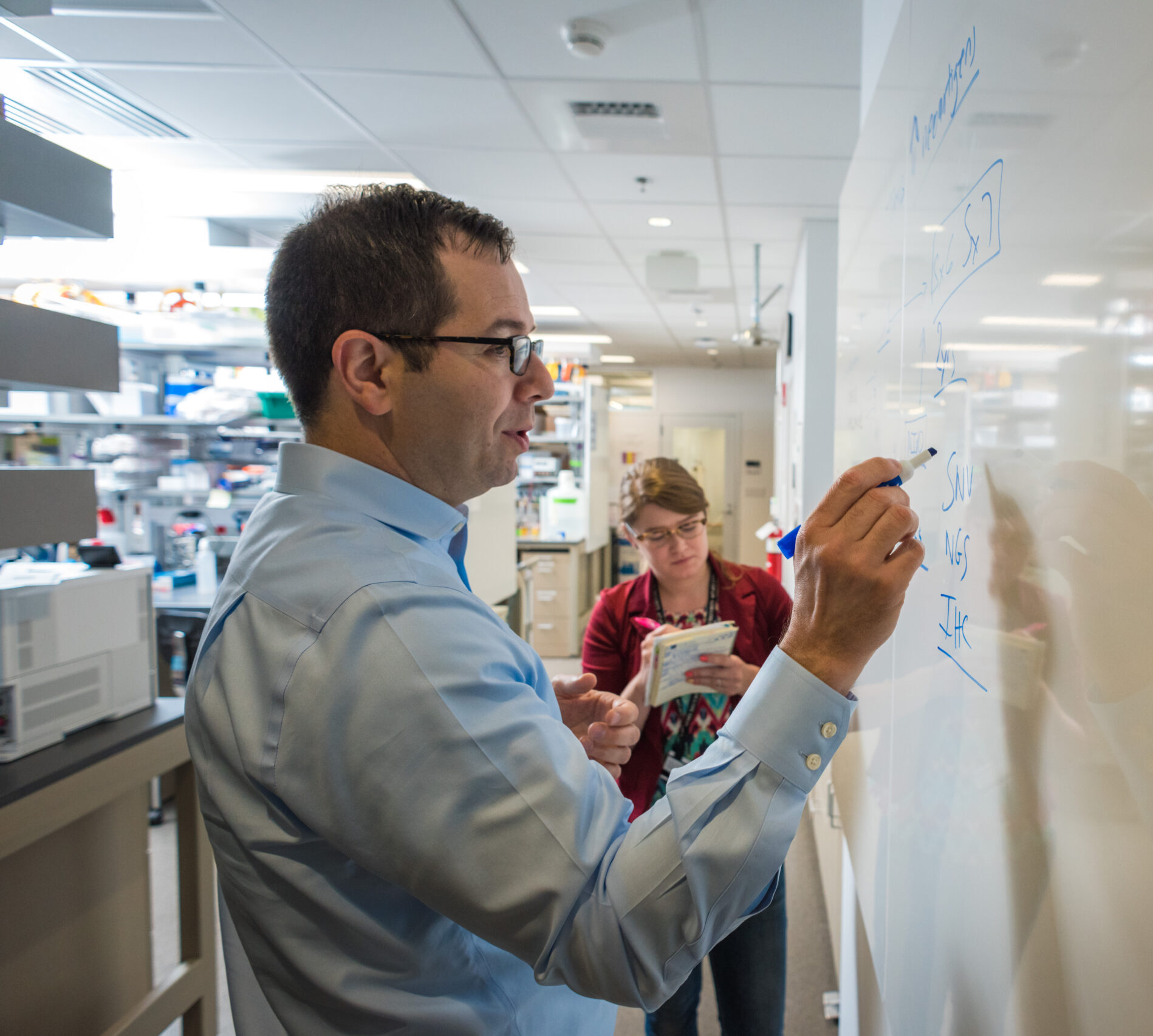The LSP Welcomes Pathology Expert Sandro Santagata as New Associate Director

Santagata’s promotion to Associate Director cements his long-standing commitment to the LSP. Since joining in 2017, Santagata has played a pivotal role in building the LSP’s precision medicine portfolio, helping to develop the approaches and insights needed to translate research insights to the clinic.
“Sandro is a remarkable individual,” said LSP Founding Director Peter Sorger. “He has had a transformative impact on the lab, bringing our science much closer to the clinic and tackling today’s preeminent medical challenge: determining how to match individual patients to an optimal treatment.”
Santagata’s research career has been driven by the mission to identify disease mechanisms and translate them into clinical applications. His graduate school research helped identify the genetic cause of the rare immunodeficiency disorder Omenn syndrome, leading to genetic tests to screen for the disease. This work inspired Santagata, showing him that basic science research could have a rapid clinical impact on patient care.
This translational success drove Santagata to complete his MD-PhD and focus his medical training on pathology. “I wanted to truly understand how diseases work,” he said. “To do that, I felt like I had to study human tissues. To this day I sign out cases, and I find this invaluable for staying in touch with the clinical reality of cancer diagnosis and treatment.”
Santagata’s pathology research fellowship at Brigham and Women’s Hospital led to another translational discovery, identifying that three distinct brain tumors share a common genetic mutation in the gene BRAF. This insight led to clinical collaborations and resulted in a practice-changing Phase II clinical trial to target these mutations.

For Santagata, these experiences cemented the need to translate research insights to the clinic and attracted him to the LSP, where Director Peter Sorger and Executive Director Laura Maliszewski had established a laboratory committed to developing quantitative tools to improve how diseases are understood, diagnosed, and treated.
Santagata was particularly excited by the LSP’s new high-plex imaging method, cyclic immunofluorescence (CyCIF), which made it possible to quantitatively profile the molecular features of cells and tissues at an unparalleled depth. Santagata believes molecular imaging tools will be invaluable to pathologists, who often lack access to quantitative data.
“Quantitative imaging tools are extraordinarily powerful, but disseminating them is key. One of my highest goals is to get these tools into the hands of clinical pathologists who diagnose diseases daily. They understand the critical questions from the perspective of disease development, diagnostics, and therapy.”
An NCI-funded collaboration with Sorger and RareCyte Inc. brought high-plex imaging closer to a clinical reality via the Orion microscope. Orion can rapidly image the same tissue sample for high-plex molecular targets and the stains required for clinical diagnosis. This makes high-plex imaging faster, less expensive, and ultimately more accessible for clinicians.
Santagata sees a future where these tools fit into clinical workflows and allow pathologists to precisely diagnose and treat disease.
An example of this vision is Santagata’s ovarian cancer research, which aims to understand the molecular transitions that occur in tumor and immune cells as precancerous lesions develop into invasive cancer. His team recently partnered with Professor Ronny Drapkin, a Pathologist in Obstetrics & Gynecology at the University of Pennsylvania and an expert in ovarian cancer, to apply the latest methods for multiplexed imaging and spatial transcriptomics to clinical samples. This generated an extensive dataset that characterized different stages of tumor development at a proteomic and transcriptomic level. Santagata and Drapkin’s team used these data to derive insights, observing features of inflammation and dysregulated immune cell behavior in early pre-cancer stages.

Ultimately, Santagata hopes that this work will guide improved methods for diagnosing ovarian cancer at early stages and lead to strategies for intercepting or preventing cancer development. His team is making the data available to the scientific community through the Gray BRCA Pre-Cancer Atlas, to ensure that other ovarian cancer experts can use the data to spur progress.
Santagata’s lab includes members from different scientific backgrounds and career stages – from research technicians preparing for medical school to post-doctoral or clinical fellows. Santagata finds this role as a mentor incredibly satisfying. “Not everyone fully believes that they’re capable of doing important things,” he said. “Keeping them on track to learn that for themselves – that they can do important work – is a source of joy that I plan to continue here at the LSP.”
Regardless of their career stage, Santagata hopes that his lab prepares his trainees for a career that advances science and the standards of patient care.
“We’re at this extraordinary moment for the field of pathology. We’re on the cusp of learning so much about disease mechanisms. I believe these insights will give us opportunities to rapidly impact patient care,” Santagata reflected.
“I will facilitate teams that embrace this, pairing clinical pathologists with folks who have the quantitative expertise necessary to extract new insights. There’s a lot of work to do, but I think the LSP is on track to develop the methods, knowledge, and team to do it.”
Latest News





